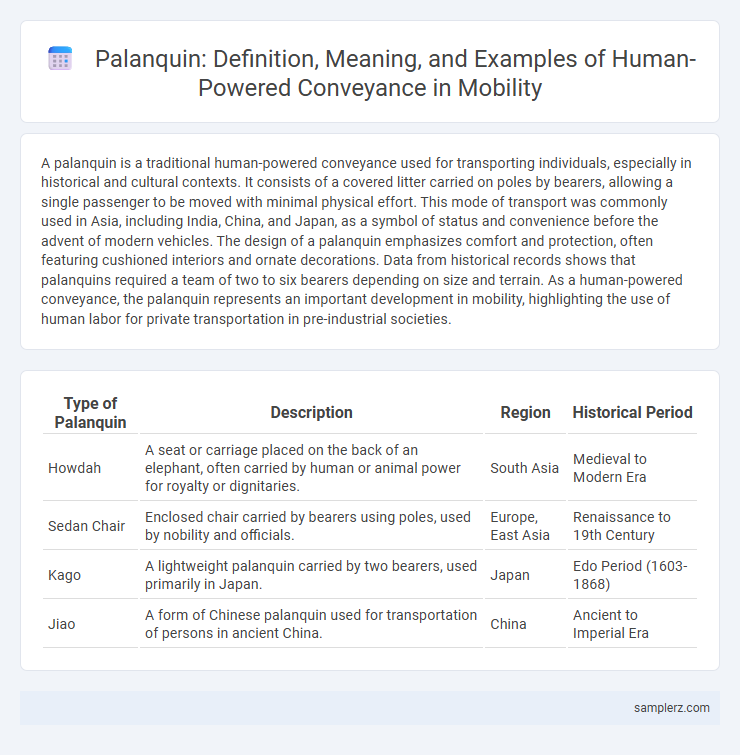A palanquin is a traditional human-powered conveyance used for transporting individuals, especially in historical and cultural contexts. It consists of a covered litter carried on poles by bearers, allowing a single passenger to be moved with minimal physical effort. This mode of transport was commonly used in Asia, including India, China, and Japan, as a symbol of status and convenience before the advent of modern vehicles. The design of a palanquin emphasizes comfort and protection, often featuring cushioned interiors and ornate decorations. Data from historical records shows that palanquins required a team of two to six bearers depending on size and terrain. As a human-powered conveyance, the palanquin represents an important development in mobility, highlighting the use of human labor for private transportation in pre-industrial societies.
Table of Comparison
| Type of Palanquin | Description | Region | Historical Period |
|---|---|---|---|
| Howdah | A seat or carriage placed on the back of an elephant, often carried by human or animal power for royalty or dignitaries. | South Asia | Medieval to Modern Era |
| Sedan Chair | Enclosed chair carried by bearers using poles, used by nobility and officials. | Europe, East Asia | Renaissance to 19th Century |
| Kago | A lightweight palanquin carried by two bearers, used primarily in Japan. | Japan | Edo Period (1603-1868) |
| Jiao | A form of Chinese palanquin used for transportation of persons in ancient China. | China | Ancient to Imperial Era |
Introduction to Palanquins in Human Mobility
Palanquins represent an ancient form of human-powered conveyance, relying on carriers to transport individuals through manual lifting and coordination. This mobility solution facilitated movement in areas lacking developed infrastructure, particularly in hilly or crowded urban environments. The design of palanquins optimized weight distribution and ergonomic carrying techniques to enhance travel efficiency and comfort for passengers.
Historical Origins of Palanquin Transport
Palanquins, a prominent example of human-powered conveyance, originated in ancient civilizations such as India and China, where they served as luxurious transport for royalty and nobility. These portable chairs or beds, carried by bearers, enabled mobility across varied terrains without relying on animal or mechanical power. Historical records from the Maurya Empire and Qin Dynasty highlight the palanquin's significance in social hierarchy and ceremonial functions.
Types of Palanquins Across Cultures
Palanquins, as human-powered conveyances, vary significantly across cultures, reflecting regional craftsmanship and social hierarchies. In South Asia, the "doli" features ornate wooden panels and cushioned interiors, often carried by four or six bearers, while East Asian versions like the Chinese "jiao" emphasize lacquered finishes and intricate carvings. African palanquins, such as the Yoruba "oke ida," typically incorporate vibrant textiles and are designed for ceremonial use, highlighting the diverse cultural expressions of mobility throughout history.
Notable Examples of Palanquin Usage
Notable examples of palanquin usage include the traditional Japanese "norimono," used by samurai and nobility for dignified transport, and the Indian "palki," prominently featured in royal processions and religious ceremonies. In Southeast Asia, the Burmese palanquin known as "phaungdaw," served both ceremonial and practical purposes, carried by multiple bearers to navigate challenging terrains. These human-powered conveyances highlight cultural significance and social hierarchy, emphasizing their role in pre-modern mobility across various regions.
Palanquin Design and Construction
The palanquin features a lightweight wooden frame reinforced with bamboo, ensuring durability and ease of transport while distributing weight evenly across bearers' shoulders. Intricate carvings and cushioned interiors reflect cultural aesthetics combined with functional design to maximize passenger comfort during movement. Its modular construction allows quick assembly and disassembly, highlighting traditional craftsmanship adapted for efficient human-powered conveyance.
Societal Roles and Status Symbolism
The palanquin exemplifies human-powered conveyance historically reserved for nobility, symbolizing elevated social status and authority within hierarchical societies. Carried by multiple bearers, it functioned not only as a practical mode of transport but also as a potent emblem of prestige and power. Its usage underscored societal roles by visually distinguishing leaders and elites from common individuals in cultural and ceremonial contexts.
Palanquin-Borne Ceremonies and Rituals
Palanquins have historically served as prestigious human-powered conveyances in various cultures, often reserved for royalty and nobility during ceremonial events. These elaborately decorated carriers symbolize social status and spiritual significance, prominently featured in religious processions, weddings, and coronations. The ritualistic use of palanquins emphasizes the harmony between human mobility, cultural heritage, and symbolic representation in ceremonial contexts.
Decline and Legacy in Modern Transport
The palanquin, once a prevalent human-powered conveyance in Asia, experienced a steep decline with the advent of mechanized transport during the Industrial Revolution and the rise of automobiles in the 20th century. Despite its reduced practical use, the palanquin's legacy endures in ceremonial and cultural contexts, influencing modern human-powered mobility designs like rickshaws and wheelchair adaptations. Historical significance and traditional craftsmanship of palanquins continue to inspire sustainable urban transport solutions emphasizing manual propulsion and heritage preservation.
Artistic Depictions of Palanquins
Artistic depictions of palanquins vividly illustrate their intricate craftsmanship and cultural significance as human-powered conveyances. Historical paintings and sculptures often showcase elaborate designs, featuring ornate carvings, vibrant textiles, and symbolic motifs that highlight social status and ceremonial importance. These visual representations emphasize the fusion of mobility and artistry, reflecting both functional and aesthetic values in traditional transport systems.
Preservation and Display in Museums
The palanquin, an ancient human-powered conveyance, is preserved and displayed in museums worldwide, highlighting its historical and cultural significance in traditional mobility. Detailed craftsmanship, including intricate woodwork and fabric decorations, is showcased to emphasize its role in ceremonial and social transport. Museum exhibits often include contextual information about its use in various cultures, aiding in educating visitors on the evolution of human-powered transportation methods.

example of palanquin in human-powered conveyance Infographic
 samplerz.com
samplerz.com